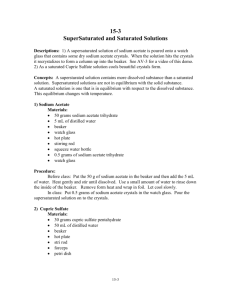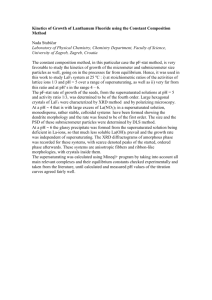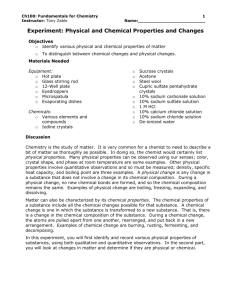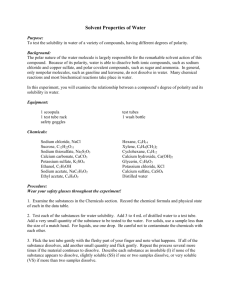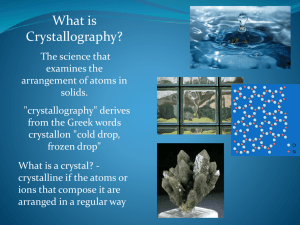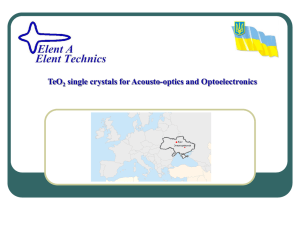Hot Packs, Chemical "Stalagmites"
advertisement
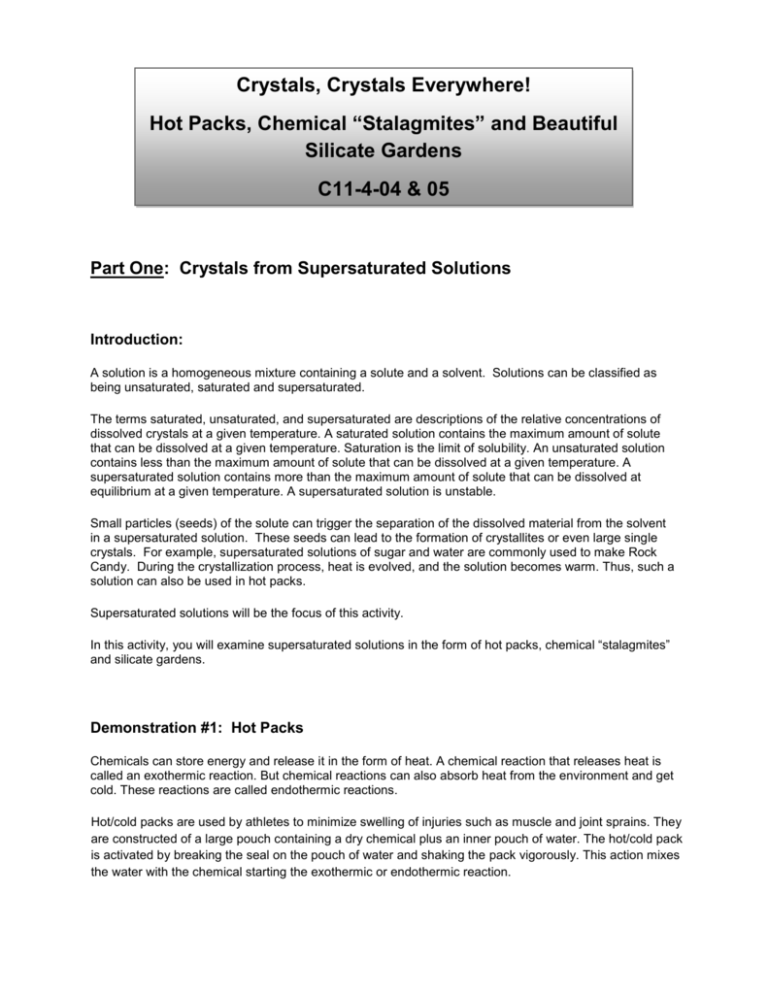
Crystals, Crystals Everywhere! Hot Packs, Chemical “Stalagmites” and Beautiful Silicate Gardens C11-4-04 & 05 Part One: Crystals from Supersaturated Solutions Introduction: A solution is a homogeneous mixture containing a solute and a solvent. Solutions can be classified as being unsaturated, saturated and supersaturated. The terms saturated, unsaturated, and supersaturated are descriptions of the relative concentrations of dissolved crystals at a given temperature. A saturated solution contains the maximum amount of solute that can be dissolved at a given temperature. Saturation is the limit of solubility. An unsaturated solution contains less than the maximum amount of solute that can be dissolved at a given temperature. A supersaturated solution contains more than the maximum amount of solute that can be dissolved at equilibrium at a given temperature. A supersaturated solution is unstable. Small particles (seeds) of the solute can trigger the separation of the dissolved material from the solvent in a supersaturated solution. These seeds can lead to the formation of crystallites or even large single crystals. For example, supersaturated solutions of sugar and water are commonly used to make Rock Candy. During the crystallization process, heat is evolved, and the solution becomes warm. Thus, such a solution can also be used in hot packs. Supersaturated solutions will be the focus of this activity. In this activity, you will examine supersaturated solutions in the form of hot packs, chemical “stalagmites” and silicate gardens. Demonstration #1: Hot Packs Chemicals can store energy and release it in the form of heat. A chemical reaction that releases heat is called an exothermic reaction. But chemical reactions can also absorb heat from the environment and get cold. These reactions are called endothermic reactions. Hot/cold packs are used by athletes to minimize swelling of injuries such as muscle and joint sprains. They are constructed of a large pouch containing a dry chemical plus an inner pouch of water. The hot/cold pack is activated by breaking the seal on the pouch of water and shaking the pack vigorously. This action mixes the water with the chemical starting the exothermic or endothermic reaction. In this activity, we will look specifically at hot packs. An example of a commercial hot pack is shown below: How do Hot Packs Work? These products consist of a concentrated aqueous salt solution together with a flexible metallic activator strip (usually stainless steel) in a sealed, flexible container. Sodium acetate and calcium nitrate are examples of suitable salts. The flexible metal strip is bent back and forth a few times, whereupon a white cloud of crystals begins to precipitate. Within seconds, the entire pack is filled up with solid crystalline needles of sodium acetate without any solution left, and the temperature rises to about 55°C for about 30 minutes. Because heat is released upon this precipitation, it is called an exothermic reaction. The activator is a thin metal piece with ridges and a specially roughened surface. The flexing causes metalto-metal contact that releases one or more very tiny particles of metal from the roughened surface. This acts as a nesting site for one crystal deposited from the solution and all of the crystals fall out instantly. These heat packs are reusable because, by re-heating the pack in boiling water for a few minutes, the salt redissolves and the pack again contains a clear solution. Also, the activator strip can be reused dozens of times. Observe a chemical hot pack in action or view the video below to watch the precipitation reaction. Video: How Hot Packs Work http://thermo-pad.com/how.htm Supersaturated Solution of Sodium Acetate Demonstration Commercially available hot packs use a supersaturated solution of sodium acetate. A supersaturated solution of sodium acetate can be prepared for demonstration as follows: Materials: 160 g hydrated sodium acetate (NaCH3COO•3H2O) 250 mL Erlenmeyer Flask 30 mL distilled water Hot plate Stirring rod A few crystals of sodium acetate Procedure: 1. Place 160 grams of sodium acetate in an Erlenmeyer flask and add 30 mL of water. 2. Heat the solution gently on a hot plate and stir until the crystals of sodium acetate dissolve. 3. Remove the flask from the heat and let it cool slowly without disturbing it (until near the end of class). 4. Add one or two crystals to the liquid in the flask. 5. Pass the flask around to students so that they can observe the beautiful crystals forming and feel the warmth of the crystallization. 6. Observe the crystals the following day. As the water evaporates, more and more crystals will have formed. Supersaturated Sodium thiosulfate pentahydrate, Na2S2O3 • 5H2O, could also be used to demonstrate. (View video at website below): http://www.chem-toddler.com/solutions-and-solubility/chemical-stalagmite/36-solutions-and-solubility/59supersaturated-thiosulphate.html Hot Packs and the Heat of Solution The enthalpy of solution (∆Hsoln) is the enthalpy change associated with the dissolution of a substance in a solvent at constant pressure. Heat of solution is most often expressed in kJ/mol at constant temperature. The heat of solution of a substance is defined as the sum of the energy absorbed, or endothermic energy (expressed in "positive" kJ/mol), and energy released, or exothermic energy (expressed in "negative" kJ/mol). The experimental measurement of the heat of solution of performed using a calorimeter. The crystallization observed in hot packs is exothermic, meaning it releases heat, and the heat of solution is negative (∆H<0). Demonstration #2: Chemical “Stalagmites” A Cave Stalagmite Stalactites and stalagmites are what are known as speleothems, deposits of minerals that form into cave structures and line the insides of a cave. Stalactites are the formations that hang from the ceilings of caves like icicles, while stalagmites look like they're emerging from the ground and stand up like a traffic cone. Some may take thousands of years to form, while others can grow quite rapidly. The two formations are also sometimes referred to collectively as dripstone. Stalactites: Most stalactites are found in limestone caves and are mainly composed of calcite, a mineral commonly found in sedimentary rocks. Calcite molecules are made of calcium and carbonate ions, also called calcium carbonate. When rainwater falls over a cave and trickles through rocks, it picks up carbon dioxide and minerals from limestone. If we add water, carbon dioxide and calcium carbonate together, the following reaction results: H2O + CO2 + CaCO3 Ca(HCO3)2 Water carries the Ca(HCO3)2 (calcium bicarbonate) through cracks in a cave’s roof. Once water comes into contact with the air inside the cave, however, some of the calcium bicarbonate is transformed back into calcium carbonate, and calcite starts to form around the crack. As water continues to drip, the length and thickness of the calcite grows, and eventually a stalactite forms on the ceiling. It can take a very long time for most stalactites to form — they usually grow anywhere between a quarter-inch and an inch every century. Stalagmites When water and calcite deposits from stalactites drip on cave floors, it forms calcite mounds known as stalagmites. Over time, the drips and mounds might even merge to form one large column, like you would see at Carlsbad Caverns in New Mexico or Timpanogos Cave in Utah. If you ever forget which one is which, here is a way to get stalactites and stalagmites straight. Stalactite has a "c" in it, as in "c" for "ceiling", and stalagmite has a "g" in it, as in "g" for "ground." You can form your own chemical “Stalagmite” using sodium acetate. View the video below in place of or addition to the demonstration. Sodium Acetate “Stalagmite” Demonstration on Video: http://video.aol.com/video-detail/chemical-stalagmite/3029473408 Sodium Acetate “Stalagmite” Demonstration: This is a demonstration used to show the rapid crystallization of a supersaturated solution in a spectacular way and explore the energy change involved. A supersaturated solution of sodium acetate is poured onto one small sodium acetate crystal. Crystals form from the liquid immediately upon contact with the seed crystal. Within minutes, the crystals become a solid mound of material that builds up into a fairly tall vertical structure The crystallization process is exothermic. Materials Beaker (250 mL) Graduated cylinder (25 mL) Distilled water Watch glass (large, about 10 cm diameter) Stirring rod Hot plate Electronic balance 125g hydrated sodium acetate (NaCH3COO•3H2O) The ‘stalagmite’ can be re-heated and used again. Keep the solution clean and free from dust – this could cause it to crystallize prematurely. Procedure: 1. Weigh 125 g of the hydrated sodium acetate into the 250 mL beaker and add 12.5 mL of water. 2. Heat the beaker on a hot plate and stir until a clear solution is obtained. 3. Cover the beaker with a watch glass and allow to cool to room temperature to give a supersaturated solution. 4. Remove the watch glass and place a few crystals of sodium acetate on it. 5. Pour the supersaturated solution slowly onto the sodium acetate crystals. The solution should crystallize immediately on contact with the crystals. It will form a growing ‘stalagmite’ of solid sodium acetate as more and more of the solution is poured onto it. Notice that the watch glass becomes warm as heat is released during the crystallization process. Potassium Nitrate Demonstration (Optional): Another interesting demonstration using potassium nitrate, KNO 3, forms several thin spears of crystals upon seeding. Simply prepare a supersaturated solution of potassium nitrate (according to the same instructions in #1-3 given above) and allow the solution to cool. Add one crystal of potassium nitrate to the solution and watch as beautiful icicle-like structures begin to grow upward. Keep until the next day and the beaker should be completely full of crystals as much of the water will have evaporated. Alternatively, students could prepare their own supersaturated solution. Part Two: Crystal Gardens Crystal gardens are plant-like structures formed by dropping a seed crystal of a soluble metal salt into an aqueous solution of one of several anions such as aluminates, borates, carbonates, chromates, cyanoferrates, phosphates, or silicates. The most commonly-used anion, however, is silicate, present in sodium silicate (water glass) and hence the alternative name of silicate garden. As the name indicates, the chemical 'horticulturalist' will observe a growth of fronds, similar in form to plants or stalagmites you might find in caves, taking place over a period of minutes to hours. When you drop crystals of a soluble metal salt into sodium silicate solution, the sodium ion is replaced by the metal ion. The resulting metallic silicate is not soluble in water, (i.e. it precipitates), and has a color characteristic of the metal (e.g. copper is blue). The metallic silicate is also a gel, so it expands, and grows into colorful stalagmites in the water. Student Activity: Preparation of a Crystal Garden In this activity, students will observe the formation of a crystal garden using a solution of sodium silicate and colored metal salt crystals. The crystal garden relies on the fact that most transition metal silicates are insoluble in water and are coloured. Materials Glass container or large (1000ml) beaker Sodium silicate solution (1 part sodium silicate:4 parts water) Sand (optional) Tweezers or forceps Any combination of some or all of the following chemicals: (The metal salts chosen are known to be fairly soluble in water. If a particular metal compound is unavailable, a nitrate is usually a safe choice as an alternative, and usually, the chloride.) chromium (III) chloride hexahydrate crystals (green) Iron (III) chloride crystals (brown/orange) Iron (II) sulfate crystals (green) Copper (II) sulfate crystals (blue) Nickel (II) sulfate crystals (green) Aluminum potassium sulfate crystals (white) Cobalt (II) chloride crystals (purple) Copper (II) chloride (bright green) Cobalt (II) nitrate (dark blue) Manganese (II) nitrate (white) Zinc sulfate (white) Calcium chloride (white) Manganese chloride (pink/purple) Manganese sulfate (pale pink) Caution: Do not handle any of the chemicals with bare hands – use tweezers or forceps. Procedure: 1. For aesthetic reasons an optional thin layer of sand may be placed on the bottom of the beaker or glass container. 2. Fill the beaker or glass container within 2 cm of the top of the container with sodium silicate solution 3. The solution is now ready to receive the other chemicals. Using the tweezers, drop these carefully onto the surface, vertically above the place you would like them to grow, in a pattern as though you were sowing a real garden. (For best results, use larger sized crystals of metal salts (pea-sized)). The very best effects are observed when you use a relatively small number of crystals and arrange these in a well separated manner at the bottom of the beaker. See the following diagram: Sodium Silicate Solution Crystals of Metal Salts 4. Do not shake or mix the solution. The 'plants' will begin to grow within a few minutes. Below is an image of a crystal garden beginning to grow: The average time to grow is about one-half hour, but frequently a garden will keep on growing almost indefinitely until it threatens to fill the entire glass container. Sometimes, when observed under a high-power magnifying glass, the actual expansion of the silicate can be noticed. 5. When the garden has ceased to grow (or if you wish to stop it growing), hold the beaker under a cold water tap and slowly allow fresh water to pour down one side of the beaker, thus flushing out the sodium silicate solution. This must be done very carefully to avoid damage to the crystal fronds. 6. When you are satisfied that all the solution has been washed away, and the beaker is filled with cold water, the top may be sealed with a lid or with a piece of plastic taped down. Under these conditions, with care, the chemical garden will survive for a long time. Explanation: When metal salts are added to a silicate solution, insoluble silicates are formed. A semi permeable membrane forms around the salt. Because the concentration is greater inside the membrane, water enters the membrane to dilute the concentrated solution (osmosis). Osmosis causes the membrane to break. It breaks upward because the pressure of water on the sides of the crystal is greater than that on the top. This process is repeated as a new membrane forms, and an upward growth results. It may be appropriate to explain to students that: 1. The metals are mostly chosen from the d-block of the periodic table (transition metals), since it is these metals that are coloured. 2. The reaction taking place is a precipitation of the metal ions with silicate ions. A simplified equation for the reaction taking place with cobalt (II) ions from the metal salt and silicate ions from the sodium silicate solution is as follows: The insoluble cobalt (II) silicate is formed. Co2+(aq) + SiO32-(aq) → CoSiO3(s) This cobalt silicate is a semi permeable membrane. Because the ionic strength of the cobalt solution inside the membrane is higher than the sodium silicate solution which forms the bulk of the tank contents, osmotic effects will increase the pressure within the membrane. This will cause the membrane to tear, forming a hole. The cobalt cations will react with the silicate anions at this tear, forming a new solid. In this way growths will form in the tanks; these will be coloured (according to the metal) and may look like plants. The crystals formed from this experiment will grow upwards, since the pressure at the bottom of the tank is higher than the pressure closer to the top of the tank, therefore forcing the crystals to grow upwards. Did you know? Sodium Silicate solution (water glass) was used in the UK to preserve eggs during World War II. The eggs were soaked in water glass. The porous calcium carbonate of the eggshell reacted with the silicate to produce insoluble calcium silicate, which blocked the pores thus rendering the egg impermeable to air. History of Crystal Gardens So-called metallic trees were first observed by people such as the German chemist, Johann Rudolf Glauber (1604 – 1668) and first studied by another German chemist, Isidor Traube in the mid-19th Century. Traube showed that membranes could be produced artificially, which were permeable to water but not for certain dissolved substances. In this respect they were similar to those membranes surrounding plant and animal cells. Among the semi permeable membranes prepared by Traube was one of copper (II) hexacyanoferrate (II), and such a membrane, formed in the walls of a porous pot, was used by the German botanist, Wilhelm Pfeffer, in 1877, for the quantitative measurement of osmotic pressure. These results showed that the osmotic pressure is proportional to the concentration of the solution, and also that it increases with rise of temperature. This research culminated in van't Hoff's law of osmotic pressure, formulated in 1887, in which he was able to apply the second law of thermodynamics. This pointed the way to a method for determining the relative molecular masses of substances in solution. Despite all this knowledge, the physical chemistry of the formation of chemical gardens is still imperfectly understood. In 1984 Independent Television News (UK) organized a competition for all schools in Great Britain to suggest an experiment to be performed in space, aboard the Space Shuttle. This was won by a school from Kent, Ashford School, who suggested a chemical garden. The students wished to find out what shape and direction the 'plants' in a chemical garden would grow under conditions of microgravity. They wrote a computer program to simulate what might happen to the garden in space and it predicted a range of possibilities from near-spherical shapes to a spherical bundle of long arms. The shuttle Endeavour launched on 12 September, 1992 and the chemical garden experiment worked very successfully. The growths were in random directions and tended to be twisted. To the surprise of the students there were also a few perfect spiral forms. At the time of reporting they had no satisfactory theory of the origins of these spirals. Crystal-growing under conditions of microgravity has a wider and deeper significance for the life sciences, where a major goal is to understand structure/function relationships of biological systems at the atomic level. For example, many important biological molecules such as proteins (which include enzymes) have yet to be adequately structurally analysed. Microgravity may provide an environment where perfect protein crystals could be produced, that are large and pure enough for more precise analysis, such as X-Ray Crystallography. This would have important applications in, for example, cancer research.
